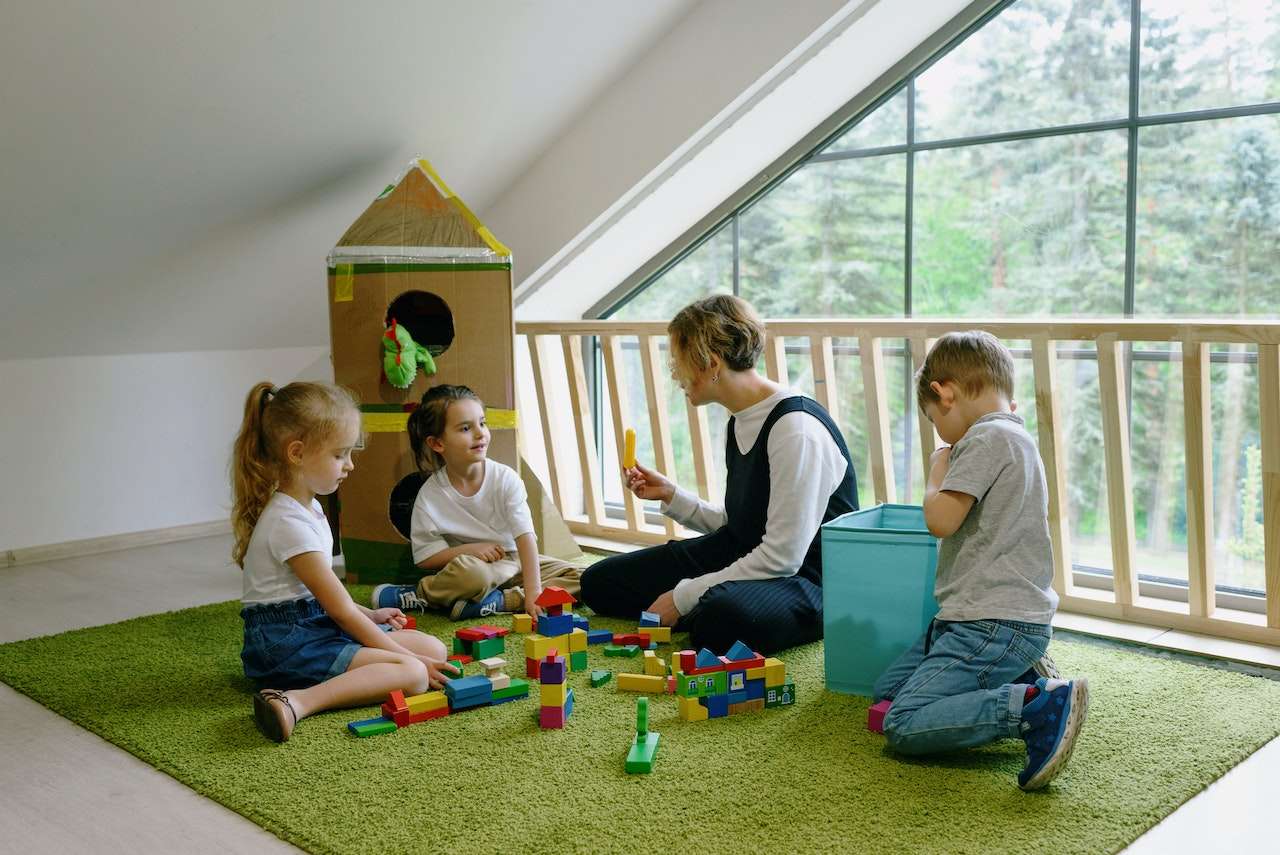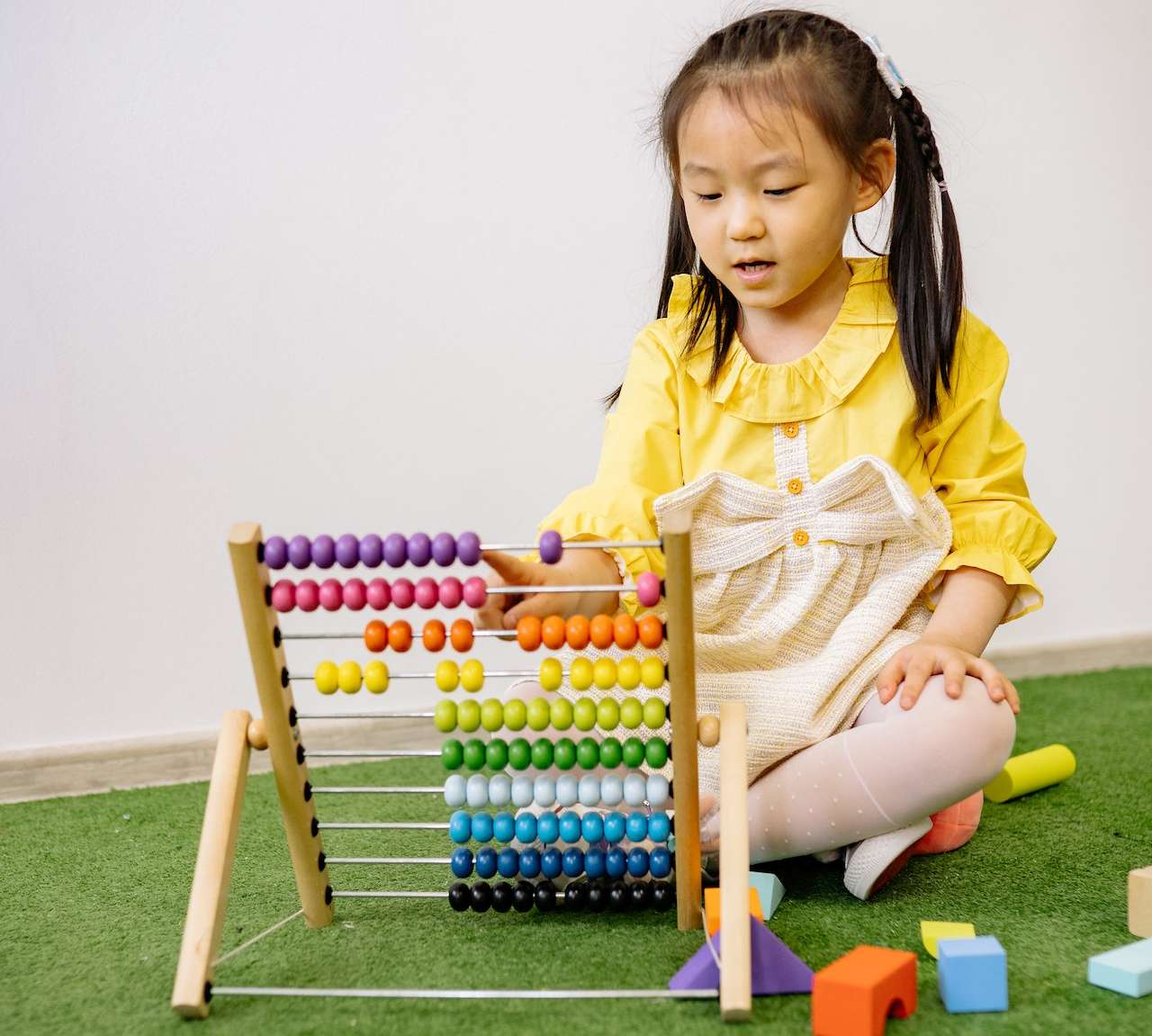Humans interact with each other and the environment using their five senses.
- Sight (seeing)
- Auditory (Hearing)
- Tactile ( Touching)
- Olfactory (Smelling)
- Gustatory (Taste)
Children are highly receptive to developing their senses from 2-6 years of age.
In fact, experiences which utilize all the senses are essential for children at these ages.
What are Montessori Sensorial Activities?
Montessori sensorial activities are based on a teaching approach that helps children refine and develop their senses.
They allow children to explore and understand the world using their senses. These activities need to be encouraged early in school.
These activities are based on the Montessori principles of education and are executed using Montessori Sensorial Materials.
How were Montessori Sensorial Activities developed?
Maria Montessori, a founder of Montessori, expanded the five basic senses into nine isolated sense organs to include –
- Chromatic (color)
- Baric (weight)
- Thermic (temperature)
- Stereognostic (tactile-muscular)
Montessori Sensorial materials were developed by Dr. Maria Montessori in the 1800s.
She aimed to help children sharpen their senses, analyze their environment, and absorb conceptual information.
What are Montessori Sensorial Materials?
Montessori Sensorial Materials are creative tools used in Montessori classrooms for sensorial activities.
They may be handmade or purchased. Both styles of materials follow the principles of Montessori.
You can replicate Montessori Sensorial materials at home by using high-quality materials combined with some inexpensive materials.
Below are the many benefits of Montessori Sensorial Materials:
- Develop nerve connections: These activities stimulate the child’s senses. In the future, it will help them to accomplish complicated tasks.
- Enhances memory: They help children to observe, distinguish, categorize and interpret sensory information around them. Hence, they retain the lessons better as they learn through experience.
- Promotes logical thinking and problem-solving skills: Montessori-designed materials combined with sensorial activities help them develop logical and perceptive skills. Children implement their learning with manipulative materials and eventually use these concepts in the most abstract and creative ways.
- Has control of error: If the children make mistakes while performing the activities, they can auto-correct.
- Develop social skills: They learn to work together with their peers, communicate and establish strong social interactions.
- Build confidence: These materials encourage children to be independent and self-confident by doing the activities.
- Develop language skills: They help to develop the vocabulary needed to describe and express the senses.
Different Montessori Sensorial Activities
When choosing appropriate sensorial materials for your children, you should pay attention to their interests.
Montessori Sensorial activities can be challenging for the child sometimes.
It is ideal to choose simple activities initially. You can repeat the complex activities for the child till he gets familiarized with them.
There are many activities for each of the senses.
1) Comparison of size
Using the tactile and visual senses, children can distinguish size.
These activities help them learn about size and weight and develop their Mathematical skills like counting, composing numbers, and measuring quantity.
The children develop coordination, concentration, and independence in doing things.
- The Pink Tower – The Pink Tower consists of ten graduated pink cubes of increasing sizes.
The children learn to feel the size holding them one at a time or arranging them like a flight of stairs.
They also arrange blocks to form towers. The largest is at the bottom and the smallest is at the top. - The Brown Stairs – The Brown Stairs comprise ten rectangular prisms of equal length in increasing size.
It is arranged in increasing thickness to form a staircase. It helps children in identifying thickness and thinness.
Gradually, they learn concepts of unit measurements, proportions, and geometry. - The Red Rods – They are a set of ten rods of different lengths and dimensions. Children arrange the rods in order from longest to shortest and match the length of the rods.
They help to build a child’s muscular perception of distance and visuals. - The Knobbed Cylinders – These consist of four sets of cylindrical wooden blocks with knobs.
Each set has ten cylinders of different sizes. Using these, children learn to distinguish different sizes and to measure objects.
The cylinders are removed from the knobs and replaced. This helps to learn sizes accurately. - Baric tablets – They are made of wooden tablets of different weights. These help the kids to determine the difference between the weight of the woods.
2) Distinguishing colors
Children can learn about colors from fruits and vegetables. They can be explained about colors while buying fruits or vegetables about the colors of each.
Younger children can learn about colors like a ripe banana being yellow while a raw banana is green. Older children can learn about shades.
- Color tablets – Each tablet consists of a set of tablets of a shade of color.
They consist of three color boxes. The first box has three primary colors, the second has 12 different colors and the last one has 9 colors.
The children arrange these tablets in order of color shades. By doing this, they learn to differentiate colors.
There are many other Montessori sensory materials like primary color boxes, gradation color boxes, secondary color wheels, etc to enable them to distinguish colors.
3) Tactile senses (touch)
They touch different items kept in a basket and discover how it feels. It may be fruits, and vegetables of different sizes and shapes. Children learn to describe them as oval, elongated, smooth, hard, soft, etc.
- Touch tablets – They help children to explore feelings of smoothness and roughness. Sandpapers of different textures are fixed on wooden tiles.
Children have to arrange these in order of their texture from rough to smooth.
They have to match the sandpapers of the same coarseness. This helps them to differentiate between coarse and fine.
This way the children also learn to perceive the world through touch.
4) Distinguish gustatory sense (Taste) and Olfactory sense (smell)
Children learn to explore their world through smell and taste.
Different types of fruits help children learn about tastes. These lessons can be learned at home by involving the children in your day-to-day activities.
You can take them along with you while shopping for fruits and vegetables from the market.
Here is a Montessori sensorial activity for helping the children with their gustatory sense and smell.
- Tasting bottles – Tasting bottles consist of a wooden tray and eight glass bottles with a dropper.
Each bottle has a number at the bottom for easy pairing and finishing.
The children have to find two identical bottles for matching tastes.
This helps children to distinguish basic taste. They also help to develop muscle movement in the wrist and improve control and flexibility. - Smelling jars – Small bottles or jars with scented cotton balls are used to compare different smells. The children also match the jars with the same smell.
5) Distinguish shapes
The children learn about various forms and figures in this activity. They observe the transformation of concrete to non-realistic forms. Their writing also gets improved.
- Geometric Cabinet – It consists of a wooden tray section with six wood squares. Each of them represents a geometrical shape.
Children learn the names and characteristics of these shapes.
There are many other Montessori sensorial materials like constructive triangles, binomial cubes, etc which help the children to distinguish shapes.
At home, toddlers can explore making shapes with playdough or fundough.
They can make shapes using cookie cutters. It is fun learning shapes using it.
6) Thermic sense
Children should learn to distinguish between hot and cold. This will help them provide safety skills.
The Montessori Sensorial activities include Thermic Bottles and Thermic Tablets to teach children to discern between hot and cold. They can also learn about heat conductivity among different materials.
Children should learn to distinguish between hot and cold. This will help them provide safety skills.
The Montessori Sensorial activities include Thermic Bottles and Thermic Tablets to teach children to discern between hot and cold. They can also learn about heat conductivity among different materials.
- Thermic bottles – They consist of six metal bottles. Two of them contain hot water, lukewarm water in the next two, and cold water in the last two.
Children learn to differentiate temperatures touching them. - Thermic tablets – Thermic tablets are made of different materials like metal, stone, glass, plastic, and wood. They are uniform in size.
The child senses the difference between tablets using the temperatures by touching them.
They also get to explore their indoor and outdoor environments to identify things that are hot and cold.
7) Identifying sound
To understand sound, children must understand silence. This helps them to discriminate between sounds.
Then, they can explore their surroundings to identify objects that make sound or no sound.
- Sound cylinders – They are a set of six red and six blue uniform cylinders that make sounds when shaken. The cylinders of the same color make different sounds.
Similarly, the grading of sounds is also there. Children explore objects which have louder and softer sounds like salt, pebbles, sand, etc.
In this digital world, children are more exposed to online games that hardly make use of their senses.
It is our responsibility to instill physical and mental engagement in their education.
Montessori sensorial activities are perfect for your child. They will give a complete form of development by keeping them engaged and stimulating their senses.
Children will love their learning process while reaping the benefits of Montessori sensorial activities.


